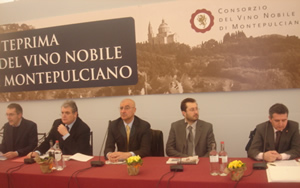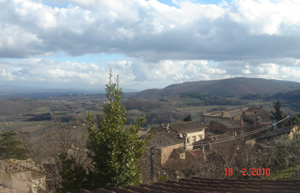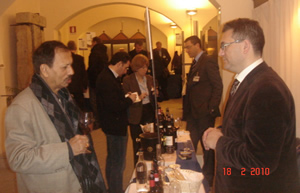When the President of Consortium of Vino Nobile Montepulciano was saying that despite the difficult vintage 2009 and no respite expected in price fall in the near future, the steady 10.5 million bottles of Nobile and Rosso were produced, thoughts drifted to India producing about the same quantity, and wondering how many people differentiated between the grape varietal and classification bearing the same name, reflects Subhash Arora who was at the tasting event.
Photos By:: Adil Arora
 |
| President Federico Carletti (M) |
President of Consorzio del Vino Nobile di Montepulciano, Federico Carletti who also owns a premium winery, Poliziano, was addressing a gathering of Italian and international journalists on February 18 in Montepulciano. He said that despite the prices coming down last year, the appellation had maintained the level of total number of bottles produced as about 110.5 million which included 8 million of Vino Nobile Montepulciano DOCG, the balance being the younger Rosso di Montepulciano DOC. He exhorted the producers to continue to improve the quality further and make sure the terroir was even more expressive and they could be even more proud of the quality of the product.
Montepulciano-the Grape
It is more likely that the majority of Indian wine drinkers have tasted or at least seen a Montepulciano d’Abruzzo listed on the restaurant wine list. This is an indigenous grape varietal in the region of Abruzzo just as Sangiovese is common in red Tuscan wines and Nebbiolo is the grape of Piemonte. Certainly not a noble Italian grape variety, it makes value-for-money wines, all the same.
The claims made by Abruzzo making the best Montepulciano varietal wine is challenged by the neighbouring Marche region which also grows the grape but uses it more as a blend with Sangiovese grape, making wines like Conero Rosso DOC appellation wines. Enzo Mecella of Marche-based Moncaro which entered India recently in collaboration with Riona Wines with 100% Montepulciano based le Silve is one example of such grape; the Conero Rosso from Umano Ronchi has been present in India for quite some time through Brindco.
The Noble Montepulciano Wine
Montepulciano is also a historic Tuscan city, an hour’s drive due west of Montalcino, the seat of the iconic Brunello wine. Known more for thermal springs and spas in and around, the beautiful medieval city is known for Vino Nobile di Montepulciano DOCG and the younger and less complex, Rosso di Montepulciano DOC wines. Both these wines use a minimum of 70% of Sangiovese clone known as Prugnolo Gentile but with different process specifications, both in the vineyard and the winery.
 With a fragmentation of the producers in the tiny region Ceretti emphasized that it was not feasible to build individual brands and so it was important for the denomination to be promoted as a classification. In fact, he was candid enough to admit that Montepulciano had joined the Consortia of Chianti Classico, Brunello Montalcino as well as Prosecco to promote their wines jointly in Switzerland, UK, China and Japan as these partners already had their own established identity. With a fragmentation of the producers in the tiny region Ceretti emphasized that it was not feasible to build individual brands and so it was important for the denomination to be promoted as a classification. In fact, he was candid enough to admit that Montepulciano had joined the Consortia of Chianti Classico, Brunello Montalcino as well as Prosecco to promote their wines jointly in Switzerland, UK, China and Japan as these partners already had their own established identity.
There has been a marked increase in the investments during the last 15 years and after an excellent vintage of 2007, the quality has been looking up. More controls have been imposed internally since 2003. Through traceability, history of every bottle can be traced back. Consorzio has also been working with a pharmaceutical company to work on the bottle shape so that the problem of fake wines could be eliminated (yes, the wines are famous and important enough to encourage forgery!)
The Consorzio has tied up this year with a Trentino-based cosmetic producer, Effegilab where the compressed skins of red grapes after fermentation are being used to make cosmetics using the resveratrol of the grapes and avoiding the use of chemicals. It plans to start the production on a commercial level as the Montepulciano black grape essence cosmetic collection. But why Trentino, I wondered? Stefano Soglia, the Marketing and Communications manager of the Consorzio says, ‘we knew the producer and he was interested in our grapes. We hope this will become a successful product adding to the income of some of our members.’
The Nobile can compete with Chianti Classico but are generally more austere and need longer time to evolve and require food-generally red meat based for a good food match.
The Rosso on the other hand, are young, easier drinking fruity wines, with softer tannins and can handle vegetarian food as also chicken and fish made in a certain style. They may not be the best paired with lamb chops or steaks but can be a great combination with all types of Biryani, unseasoned cheeses, pastas and even pizzas. Costing less than half the Real McCoy, they are a great wine for the Indian palate and pocket.
The 2009 vintage has been assigned 4-stars and though Carletti liked us to believe that most produced 4-5 stars, the taste in the glass was more like 3.5-4 stars, which also means the vintage would not be as age-worthy as the usual 10 years in a good vintage. The Riserva that are to be aged for 3 years, instead of 2 years for the Vino Nobile- can normally age for even 15 years-this period will be less for 2009 vintage.
 Visits to a couple of wineries – Croce di Febo, a small organic winery and Fattoria di Cerro, a big winery- part of the big conglomerate Saiagricola were characteristic of the small guys living and sustaining in the presence of the big guys because of their passion and innovations in the winemaking. Visits to a couple of wineries – Croce di Febo, a small organic winery and Fattoria di Cerro, a big winery- part of the big conglomerate Saiagricola were characteristic of the small guys living and sustaining in the presence of the big guys because of their passion and innovations in the winemaking.
A few of the better known wineries are Avignonesi, Boscarelli, Contucci, Dei, La Braccesca (Antinori), Poliziano. Vecchia Cantina is the co-op king here. Fattoria del Cerro was dealing with India but ran into problem with the existing importer and is looking for another one. Carpineto is also being imported in limited quantities by Ace Beveragez.
It is interesting that the quantity produced by about 70 wineries in the tiny town produce approximately the same amount of wine as produced in the whole of India. Also, a good Rosso di Montepulciano, with lower costs would be a much more practical option for the Indian market.
Subhash Arora
|